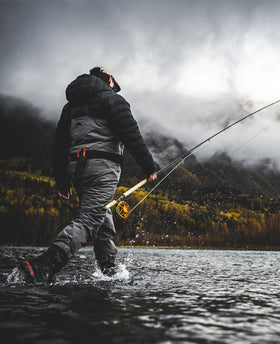
5 Tips To Improve Your Winter Nymphing
Although it’s not officially winter yet, we know it’s coming soon which means nymph rigs are going to be our best friend. Don’t let this time of the year deter you from getting out though, this is honestly one of the best times to be out there. It’s not always easy nymphing all day and sometimes can leave us scratching our heads. In order to get past this hump and make things easier, we’re going to go over 5 tips to improve your winter nymphing.
#1: Keep Your Flies Simple
A lot of people worry about what flies they should be throwing in the winter. This is the easiest step to the equation because there’s only one bug that hatches all winter and that’s the almighty midge. Winter midges are incredibly small, so get comfortable throwing flies that are size 20-26. The midge life-cycle is also an easy one to memorize so you don’t need to carry a thousand flies with you. Midges have a larval stage, pupa, emerger, and adult stage, and for us nymphing the only two you really need to worry about are the larva and pupa. Midge larva are typically red in color, but also come in olive, cream, black, chartreuse, and many more varieties. Midge pupa are little different and can be seen in various “stages” of their pupation. Some might just be a solid black, while others have begun to break their casing to emerge. Midge pupa come in a variety of colors, depending on the specific hatch that’s occurring. Typically if you have a black pupa tied on you’ll have your bases covered, but browns, tans, olives, and even purples are never bad options.
Good larva patterns are the zebra midge, red ale midge, pale ale midge, anneworm, and demon midge.
Good pupa patterns are the top secret midge, black beauty, massacre midge, butt crack midge, and the standard or flashy money midge (not in red).

Outside of midges there isn’t much else hatching except on a weird day, but we still need an attractor fly to get trout to look at our tiny midges. One of our favorite lead flies in the winter is an egg. They’re a high calorie food item that’s easy for a trout to eat and they’re just about everywhere because the browns spawned in the fall and their eggs will remain in the water until the spring. We also really like small stoneflies in the winter. The same concept that applies with the eggs, applies to the stones. They live in the water year-round and even though flows aren’t high enough to knock them around, trout won’t pass up an easy big meal. Don’t go too big though, it’s very easy to get carried away with stoneflies in the winter. Instead of the stereotypical rubber legs, opting for a size 14 or 16 hare’s ear or copper john is a solid choice.

#2: Have The Right Sized Indicator

This might seem like a duh for most of us, but a lot of the time on the water we see anglers with far too big of an indicator to effectively register any eats. Indicators typically come in three sizes, a ½” (small), ¾” (medium), and 1” (large). The large indicator should never be fished in the winter, there’s not enough water nor are the strikes aggressive enough to warrant using a balloon sized indicator. The appropriate sized indicators are the small and medium, but if your eyesight allows for it then ideally just the small. The reason we like to fish the small indicators in the winter is because strikes are often very subtle, so we want to use the smallest indicator possible to pick up the softest of eats. Don’t worry though, if your eyesight prohibits you from using the small sized indicators, the mediums will do just fine.
#3: Change Up Your Leader

There are two ways to go about having the right leader for winter nymphing. The easiest way to go is quit using your standard nylon leader you use all year and opt for a full fluorocarbon tapered leader. The reason we like the fluorocarbon leader in the winter is because depth penetration is much more important than it is in the summer. In warmer water conditions fish are more willing to rise up in the water column to eat a fly. Whereas in the winter, fish don’t want to expend as much energy to eat, therefore they’ll sit in their spot and let the food float right to them. Nylon leaders have a much more difficult time achieving this because nylon is floating material. So we switch it up to fluorocarbon because it sinks (fluoro to the floor!) at a much faster rate and allows our flies to get into the fish’s face more efficiently.
The other way we like to go about changing up our leaders is tying them ourselves! In fact, you should be tying your own nymphing leaders all the time. Tapered leaders struggle sinking at a consistent level because their taper doesn’t allow them to. Instead they sink in an arc shape which means your indicator never has direct contact with your flies. When a fish eats your flies when nymphing with a tapered leader, the arc of the leader has to straighten out before the indicator even moves. The majority of the time when this happens the fish has already let go of the fly which leads to missed or fouled fish. Whereas with a hand-tied leader we have direct contact with our flies because there typically isn’t any taper under the water, therefore our leader can sink at a consistent level and allow for much faster strike detection. Without getting too crazy, here’s two different nymphing leaders that we like to use in the shop:
Leader 1: 8-10’ of a single diameter nylon (i.e. 10lb Maxima Chameleon)
Leader 2: 5-7’ of nylon with a 3-4’ section of fluorocarbon tippet (i.e. 5’ 10lb Maxima Chameleon and 3’ 3x tippet)
#4: Have The Right Amount of Weight
Split shot is a very important factor in your nymphing rig. Without the proper amount you’ll never get deep enough or move your fly slow enough to imitate a bug properly. On the other hand, if you have too much you’ll be dragging through the bottom below where the fish are sitting, collecting weeds, or breaking off on snags. Playing with your weight all day is important to ensure a proper drift. One thing that we recommend, particularly during the winter months, is using tungsten putty to make micro adjustments with ease. Micro adjustments aren’t always necessary, but when fish are sitting in weird currents and/or slow water it makes it a lot easier to have flies drift through the proper zone and at the proper pace. Tungsten putty can be used with split shot or by itself.
#5: Try To Sight Fish

During the colder months, fish tend to sit in deeper run or holes where the current isn’t as strong so they don’t have to expend as much energy. There are a few exceptions to this rule, but for the most part this holds up. This is important to keep in mind because you might be fishing the wrong water. More importantly, not every run or hole is going to hold fish (or at least a fishable amount). Trying to find large pods of fish will reduce wasted time on the water which is rather important because the amount of time we have to fish during the day is limited in the winter. In addition to finding fish, it’s even more important to find fish that are actively eating. A lot of fish in the winter will not spend a lot of time feeding, so throwing casts to fish that aren’t eating is the same as fishing water without trout at all. Once you find a group of fish that’s actively eating, try to single out one fish and spend your time making accurate and proper drifts to it. This will greatly increase your catch rate and avoid even more time wasted. We know that this isn’t always possible, but if the opportunity is there it’s the best way to spend your time. Waters like the Blue, Deckers, Cheesman, and our other tailwaters offer endless sight fishing opportunities and is honestly our preferred method of fishing even in the summer months.
We hope these 5 tips will help you out during the winter months and improve your catch rate while nymphing. If you have any questions about this article or winter nymphing in general, feel free to reach out to Xavier via email at xavier@goldenflyshop.com, or you can call the shop at 303-330-1292.




Comments
Leave a comment